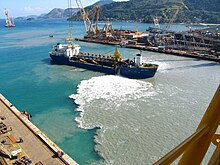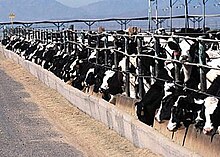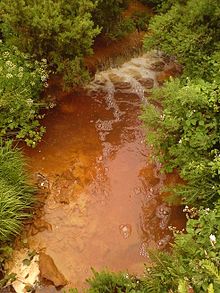Categories
Surface water and groundwater have often been studied and managed as separate resources, although they are interrelated.
[7] Surface water seeps through the soil and becomes groundwater. Conversely, groundwater can also feed surface water sources. Sources of surface water pollution are generally grouped into two categories based on their origin.
Point sources
Point source water pollution refers to contaminants that enter a waterway from a single, identifiable source, such as a
pipe or
ditch. Examples of sources in this category include discharges from a
sewage treatment plant, a
factory, or a city
storm drain. The U.S.
Clean Water Act (CWA) defines point source for
regulatory enforcement purposes.
[8] The CWA definition of point source was amended in 1987 to include
municipal storm sewer system
Categories
Surface water and groundwater have often been studied and managed as separate resources, although they are interrelated.
[7] Surface water seeps through the soil and becomes groundwater. Conversely, groundwater can also feed surface water sources. Sources of surface water pollution are generally grouped into two categories based on their origin.
Point sources
Point source pollution - Shipyard - Rio de Janeiro.
Point source water pollution refers to contaminants that enter a waterway from a single, identifiable source, such as a pipe or ditch. Examples of sources in this category include discharges from a sewage treatment plant, a factory, or a city storm drain. The U.S. Clean Water Act (CWA) defines point source for regulatory enforcement purposes.
[8] The CWA definition of point source was amended in 1987 to include municipal storm sewer systems, as well as industrial stormwater, such as from construction sites.
[9]
Non–point sources
Non–point source (NPS) pollution refers to diffuse contamination that does not originate from a single discrete source. NPS pollution is often the cumulative effect of small amounts of contaminants gathered from a large area. A common example is the leaching out of nitrogen compounds from fertilized agricultural lands. Nutrient runoff in stormwater from "sheet flow" over an agricultural field or a forest are also cited as examples of NPS pollution.
Contaminated storm water washed off of parking lots, roads and highways, called urban runoff, is sometimes included under the category of NPS pollution. However, this runoff is typically channeled into storm drain systems and discharged through pipes to local surface waters, and is a point source. However where such water is not channeled and drains directly to ground it is a non-point source.
s, as well as industrial stormwater, such as from construction sites.
[9]
Non–point sources
Non–point source (NPS) pollution refers to diffuse contamination that does not originate from a single discrete source. NPS pollution is often the cumulative effect of small amounts of contaminants gathered from a large area. A common example is the leaching out of nitrogen compounds from fertilized agricultural lands. Nutrient runoff in stormwater from "sheet flow" over an agricultural field or a forest are also cited as examples of NPS pollution.
Contaminated storm water washed off of parking lots, roads and highways, called urban runoff, is sometimes included under the category of NPS pollution. However, this runoff is typically channeled into storm drain systems and discharged through pipes to local surface waters, and is a point source. However where such water is not channeled and drains directly to ground it is a non-point source.






